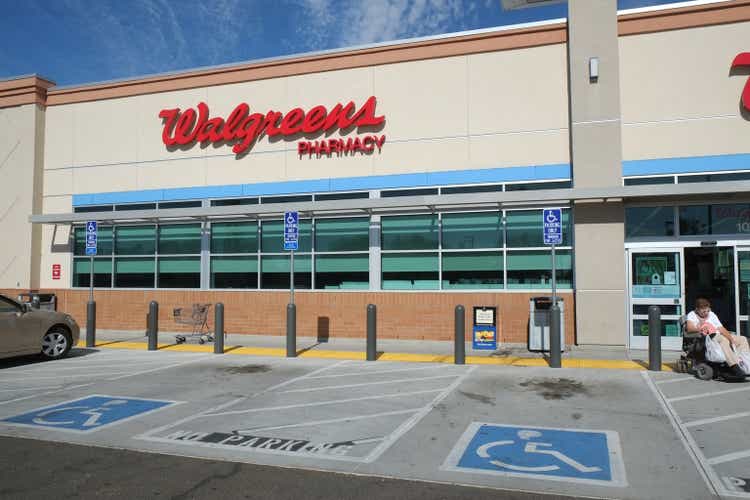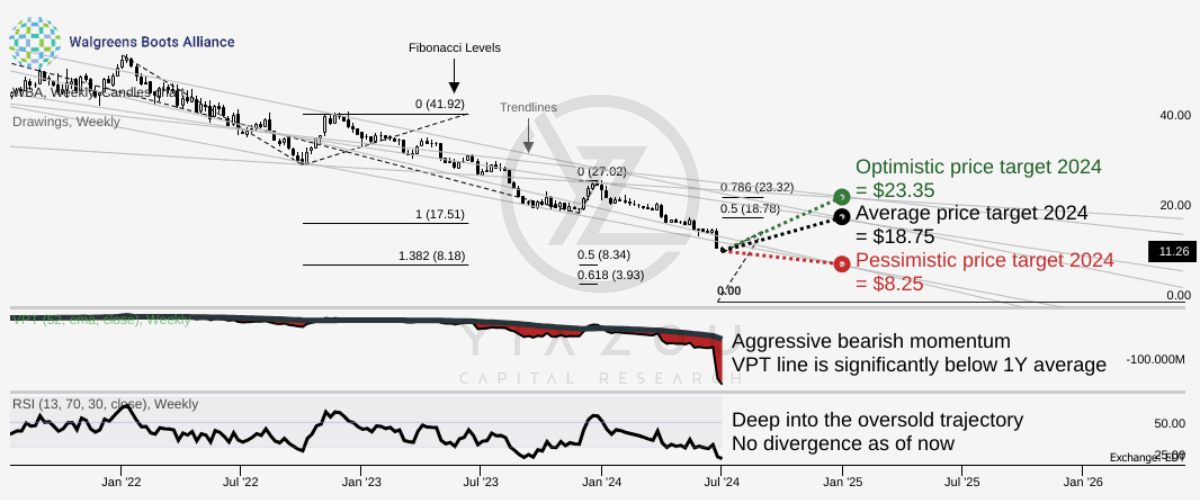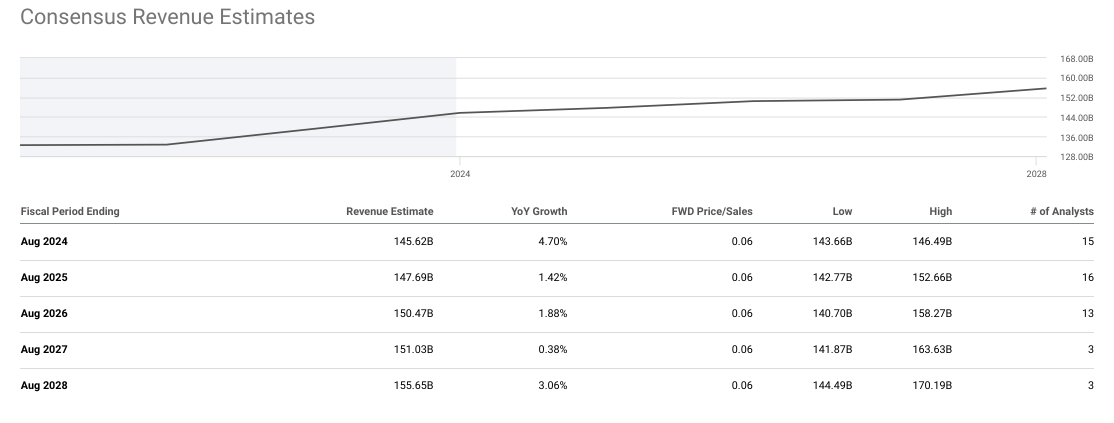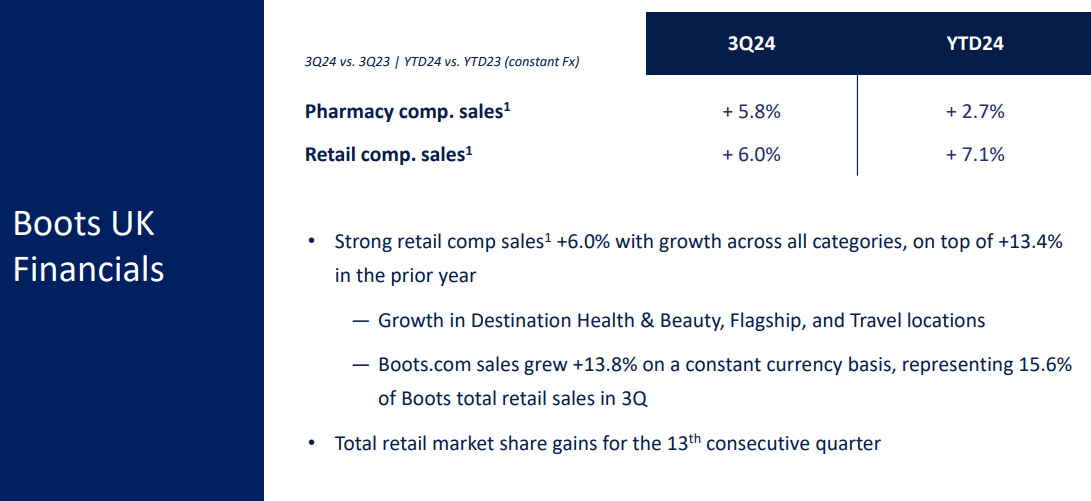Summary
- Walgreens issued $750 million in senior unsecured notes at 8.125%, refinancing 3.800% notes due in 2024, leading to a $32.4 million increase in annual interest costs.
- Walgreens sold its remaining Cencora shares for $1.1 billion, with a potential $55 million annual interest expense savings, reducing its ownership in Cencora from 12% to 10%.
- The $750 million raised will primarily reduce Walgreens' existing debt, signaling confidence in handling higher debt servicing costs. The funds will also be allocated for potential growth investments.
- Walgreens' partnership with Instacart to accept SNAP/EBT payments online at over 7,500 stores could potentially generate $200 million in annual sales, broadening its customer base.
- Walgreens reported a 37% YoY drop in adjusted EPS to $0.63 but highlighted $1 billion in targeted cost savings, potentially adding $400 million to operating income.

slobo/iStock Unreleased via Getty Images
Investment Thesis
Our previous analysis highlighted Walgreens Boots Alliance's (NASDAQ:WBA) persistent downward trajectory, which technical analysis confirmed. Significant challenges have driven this decline, including reduced demand for COVID-19 services and tightening prescription drug reimbursements. These headwinds have contributed to WBA's staggering 80% market value loss over the past five years. WBA stock is trading at $10.79, showing a strong downtrend, but all technical indicators indicate a bearish momentum at an oversold level.
Additionally, Walgreens' strategic debt reorganization, including issuing $750 million in senior notes and selling its Cencora shares, reflects a concerted effort to stabilize its balance sheet and lower interest expenses. By aggressively paying down debt and securing higher cash flow projections, Walgreens is positioning itself to manage higher debt servicing costs and return to healthier financial footing.
Finally, the combination of debt restructuring, cost management, and healthcare expansion supports the case for a potential recovery over the next 1-2 years. While risks remain, these strategic efforts may unlock value, confirming our hold rating for the stock.

Yiazou (trendspider.com)
Walgreens Bets Big: High-Rate Debt Refinance Signals Confidence
In August 2024, Walgreens closed the pricing of $0.75 billion in senior notes at a rate of 8.125% (due in 2029). This move reflects the company's strategic decision to manage its debt, which can have several implications. The issuance of these notes allows Walgreens to refinance its existing debt of 3.8% notes due in 2024.
By locking in a higher interest rate for the mid-to-long term, Walgreens is managing its capital structure under the higher-for-longer state of rates. On the positive side, the decision to refinance with a significant increase in interest rates (from 3.8% to 8.125%) indicates the company's anticipation of cash flows being robust enough to handle higher debt servicing costs.
Moreover, the increase in interest expense would be approximately $32.4 million annually. However, the company can service this debt with higher-cost capital through its projected earnings growth and cash flow generation capabilities.
Furthermore, using remaining funds for general corporate purposes marks constraints attached to immediate operational needs. The decision to issue these notes at a higher interest rate also points to the company's belief that investments will yield returns that exceed the increased cost of debt. Overall, the new issuance will reverse the long-term debt back to August 2023 levels.

WBA 10Q
However, on August 1, 2024, Walgreens announced the sale of shares in Cencora for $1.1 billion. The transaction included $818 million from the sale under Rule 144 and a concurrent $250 million share repurchase by Cencora. The proceeds from this sale will go primarily for debt paydown. This decision points to Walgreens' focus on improving its balance sheet by reducing its debt burden. By paying down debt, Walgreens can lower its interest expenses, which could improve its balance-out effect of the $750 million in senior unsecured notes.
The $1.1 billion raised through this sale represents a high liquidity injection. If these proceeds are used to retire debt with an average interest rate of 4%, Walgreens could save $44 million annually in interest expenses. This reduction in obligations strengthens the company's balance sheet. Moreover, the sale reduced Walgreens' ownership in Cencora from 12% to 10%, indicating a strategic decision to monetize non-core assets. Hence, this move allows Walgreens to benefit from any appreciation in Cencora's stock value while freeing up capital for the debt reduction.

WBA 10Q
Walgreens Taps Into $4.8B Market with SNAP/EBT Move
Walgreens' collaboration with Instacart to accept SNAP/EBT payments nationwide represents a significant move. This partnership allows using SNAP/EBT benefits for online purchases at over 7,500 Walgreens stores. This initiative expanded Walgreens' target customer base by over 40 million individuals.
With this online purchasing option, Walgreens may attract more low-income customers with limited access to transportation or live in food deserts. This move aligns with broader industry trends in retail, focusing on increasing inclusivity and network accessibility. As a result, the ability to serve a more significant population segment may boost sales volume for Walgreens, with 96% of US households enrolled in SNAP, which has expanded its potential market reach.
Assuming that a modest percentage of these households (say 20%) utilize Walgreens for some purchases, this could significantly increase transaction volume. If each of these households spends an average of $50 monthly on SNAP-eligible items, Walgreens' top-line could increase by $4.8 billion (20%*40 million*$50*12) in annual sales from this segment alone.
Additionally, the omnichannel experience that integrates online and in-store shopping may improve customer loyalty and repeat purchases. By offering SNAP/EBT payment options online, Walgreens may drive further traffic online and in physical stores. Finally, this potential expansion may lift revenue estimates (mid-point) that will benefit Walgreens' valuations.

seekingalpha.com
Walgreens Faces Q3 Slump, But Healthcare Gains Momentum
For Q3 2024, Walgreens had an adjusted EPS of $0.63, a 37% decrease year-over-year. The decline was based on several factors, including lower sale-leaseback gains, a challenging US retail environment, and negative trends in the pharmacy sector. At the top line, the company grew sales by 2.5% on a constant currency basis, with US retail pharmacy sales increasing by 2.3% and US healthcare delivering 7.6% sales growth.
Moreover, the $1 billion in targeted cost savings represents a significant effort to streamline operations. Now, if these savings directly impact operating income, Walgreens may see an improvement in its operating margin. However, the company has reduced its bottom-line guidance for fiscal 2024 to $2.80-$2.95 per share (Q3). Earlier, it was $3.20-$3.35 per share in Q2 fiscal 2024.
Moreover, the company is focused on boosting the customer experience through targeted promotions, price decisions, and omnichannel solutions. Additionally, Walgreens is actively concentrating on its pharmacy benefits management (PBM) and payer partners for fair reimbursement.
With that, Walgreens' healthcare segment had positive adjusted EBITDA and annual growth based on disciplined cost management at VillageMD and strength at Shields. This indicates that Walgreens' strategy to expand its healthcare services is beginning to pay off. The international segment also performed strongly, with Boots U.K. attaining retail comp growth and market share gains for 13 quarters.
Looking forward, Walgreens is improving its business model to match current market conditions better. It is adapting to the pharmacy sector and exploring new revenue sources. For instance, it is building out specialty pharmacy services and clinical trials.

WBA
Walgreens: Deeply Undervalued or Trap?
WBA is undervalued against sector median and historical averages in numerous ratios. Its forward P/E ratio stands at 3.81, significantly lower than the sector median of 17.87. This translates to a substantial 79% discount against the sector, meaning WBA trades at a much lower valuation than its peers. WBA's 5Y average P/E ratio is 8.19, 53% higher than its current forward P/E, signaling potential undervaluation.
On the other hand, the price-to-book (P/B) ratio of 0.65 further supports this undervaluation narrative. This is 78.08% lower than the sector median of 2.98 and 51.36% below its five-year average of 1.34. The heavy discount in the P/B ratio points to the market undervaluing the company's assets.
Moreover, the EV/Sales ratio is 0.3, 83% lower than the sector median and 43% below its long-term average. This low ratio reflects that WBA is undervalued relative to its revenue-generating capabilities, which makes it a solid value-based investment. Similarly, being a dividend-paying stock, the price-to-cash-flow (P/CF) ratio is vital at 2.73. There is a significant 77.79% discount compared to the sector median of 12.31 and 58.13% below its 5Y-average of 6.53. Here, WBA is trading at a very low multiple of its cash flow, making it an undervalued stock based on solid-liquid.
On the other hand, the EV/EBITDA ratio of 9.96 is relatively close to the sector median of 10.85, which points to a modest discount of 8.24%. Against its long-term average of 11.4, the current EV/EBITDA is 12.66% lower, which means the stock is undervalued but not drastically mispriced in EBITDA.

Analyst's compilation (seekingalpha.com)
Walgreens Boots Alliance's dividend profile is another critical factor to consider. The consensus dividend estimates suggest that WBA will continue to offer substantial dividend yields over the next few years. For fiscal 2024, the consensus dividend rate is $1.27 per share, with a yield of 11.83%. This yield is attractive considering the upcoming interest-rate cuts.
Looking further ahead, the consensus dividend estimate for fiscal 2025 and 2026 is $1 per share, with a yield of 9.32% for both years. The consistency in estimates points to analysts' expectation that WBA will sustain its dividend payments. However, this may happen at a reduced rate compared to 2024. The reduction in the dividend payout from $1.27 in 2024 to $1 in subsequent years reflects potential dividend cuts by Walgreens to preserve liquidity.
Takeaway
Despite significant challenges, including a steep decline in market value and industry headwinds, Walgreens Boots Alliance is taking strategic steps to stabilize its financial position through debt reorganization and aggressive cost-cutting. With a focused shift toward healthcare services and undervaluation in key metrics, WBA presents a potential long-term recovery opportunity for patient investors. However, the turnaround may take time, and risks remain, making it essential to monitor the company's execution of its growth strategy closely.
Comments